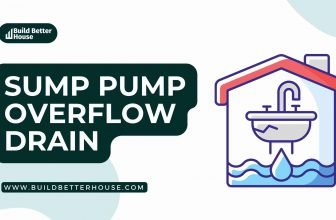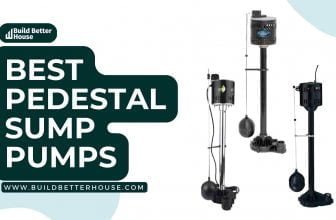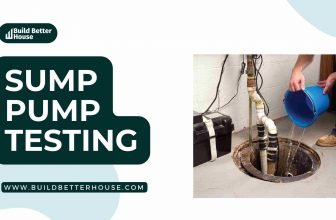5 Best Sump Pump Covers For You In 2023

Sump pump covers fit on top of your pit and keeps dirt, rocks, and other debris from falling into the pit, as well as contain loud pump noises and shield your home from foul odors that may otherwise permeate into it.
It gives the basement a great finishing touch and prevents the youngsters from playing in the pit water. Using a sump pump cover, you can stop debris from obstructing the discharge lines and smells coming from the pit.
This post will explain choosing the best sump pump cover and review some of the top covers available.
Top 5 Sump Pump Covers
If you are still determining which sump pump cover will work best for your needs, check out our top 5 picks and ideas to stop radon gas and noise from leaking into your basement.
Jackel Slotted Sump Pump Covers
The Jackel Slotted Sump Pump Covers / SF1850S is built to use primarily with an SF15 Sump Basin and either a pedestal or submersible sump pump.
The SF1850S’ long-lasting structural foam construction and injection molding ensure that it will perform dependably for many years. It has four bolts that allow for securing the basin.
These clogged sump pump covers are made of premium neoprene and fit snugly over the pump basin. You only need a screwdriver to fit it into the place since installation is effortless. It can easily accommodate most of your sump pump’s standard inlet piping, holding 1 1/2-inch inlet piping.
The Original Radon Sump Pump Covers
Original Radon Sump Pump Covers are designed with venting to satisfy two demanding requirements; a gas-tight radon mitigation cover that meets the needs of the growing radon mitigation market and a cover for replacing worn-out sump and sewage basin coverings.
The Original Radon provides a brand-new, sturdy cover that protects the basin against radon gas and odors while offering sufficient safety.
This sump pump cover from Sump Pump Supplies is a fantastic option if sewage gas frequently leaks into the basement due to the sump pit’s low water level.
It has a sizable 3″ threaded vent adapter and a 1.1/8 inch hole in the side. Structural polyethylene foam is used to create this durable cover.
Everbilt Radon Mitigation Sump Pump Cover
The Everbilt Radon Mitigation Sump Pump Cover is one of the popular products from Everbilt. The product features a unique cover system that lets homeowners and contractors quickly install the covers without visiting a hardware store.
This sump pump cover is made of durable plastic and features perforations that allow water to flow through. The inside surfaces contain notches that correspond with the lips on standard cover bolts, allowing you to connect your basin cover precisely like any other cover.
It is also adaptable, with an entire array of flanges to fit any pipe size. The basin offers several points for various connections. The retractable cover makes it easier to reach the pump owing to its clear-view, detachable inspection plate.
Homeowners can easily install the Everbilt Radon Mitigation Basin Cover over an existing basin. It establishes a new heavy-duty cover to confine and vent radon gas and odor appropriately.
Polylok 3008 Sump Pump Covers
These sturdy sump pump covers from the Polylok store have great value and hail for providing the highest UV protection and are designed to fit any 24″ diameter Polylok risers.
These sump pump covers will withstand normal residential and light commercial traffic.
It has a factory-installed gasket and an airtight and watertight basin cover. It has two recessed handles that make installation and removal simple.
It is an HDPE cover that resists fading and sliding and is available in green color.
Jackel SF16101 Sump Pump Covers
With its structural foam and injection-molded polyethylene construction, the Jackel SF16101 Sump Pump Cover is among the best in the market.
The SF16101 provides a gas and radon tight seal that fits any 18″ diameter basin and is the cornerstone of the Jackel Sump Pump Covers.
The SF16101 has proven to be one of the best sump pump covers produced. It is made of heavy-duty structural foam and comes with a molded, reusable PVC seal that offers an odor- and gas-tight seal.
This is the right option if you need a complete bolt, gasket, outlet, and inlet fitting.
How To Choose Sump Pump Covers?
The following are some significant factors to take into account when choosing sump pump covers:
Size: An essential factor to consider is the sump pump cover’s size. Since each basin varies in size, so do the covers it offers on the market. Ensure the cover you select fits correctly and doesn’t obstruct the vent pipe.
Material: Another important factor is the type of construction material. The majority of the sump pump covers are ABS and polyethylene. But select covers with UV protection if the sump pump location is towards the sun.
Holes:The placement of the holes is another>< crucial consideration when selecting sump pump covers. The appropriate output and intake pipe holes on the cover are required to fit the sump pump pipes.
Handle slots: Some sump pump covers have handles to make installation and removal simple. Consider purchasing covers with designated handle slots if you frequently need to clean your sump pit.
It’s crucial to choose sump pump covers that fit your pit to protect your pump, so keep these points in mind as you shop.
How To Install Sump Pump Covers?
Here is a step-by-step guide on how to install sump pump covers:
Step 1: Take a measuring tape and measure the diameter of the sump pit hole.
Ensure that the sump pump cover has a diameter of at least 2″ larger than the sump pit hole.
Step 2: Connect the sump pump inlet and outlet pipes.
Once the sump pump inlet and outlet pipes have been passed through, place the cover over the sump pit.
Step 3: Ensure your sump pit cover has a gasket to seal it properly.
You may purchase the seal if the cover is missing and install it along with the cover.
Step 4: Take a drilling machine and fix the sump pump cover by nailing down all the screws.
Now that you have installed the sump pump covers, you are ready to use the sump pump.
Sump Pump Covers Installation: Tips to Remember
Here are some installation requirements:
- When installing the electric sump pump, it is essential to follow the manufacturer’s instructions and ensure that the float is unobstructed. It will be possible to test the pump to ensure it works correctly and releases water in the desired manner. Installing the home’s electric meter should come before installing the pump.
- The sump pump model should have a tight-fitting cover. The cover should have an integrated gasket for airtight sealing and be made of sturdy plastic or rigid material for all penetrations for wiring, water ejection pipes, and radon vent pipes.
- Using the sump pump covers that let you view what’s happening inside the sump pit is preferable. Fasten the cover mechanically with screws or other means to maintain close contact between the gasket, lid, and crock’s rim.
If the sump is installed on a concrete floor, the exterior edge of the vault needs to caulk where it connects to the concrete.
If the sump is placed in the basement with a grime floor covered in polyethylene, ensure the polyethylene vapor barrier protects the area mainly around the sump and is plated to the rim of the vault.
How to Make Sump Pump Covers?
Do you want to make sump pump covers for your pit?
Many sump pump covers are available on the market, but with a few essential tools, materials, and carpentry abilities, you can easily save money by making your own.
Remember that only sump pumps with subfloor pipes that drain directly into a well should have this type of sealed cover. A perforated cover is an alternative if your sump pump doesn’t have subfloor pipes, but the water needs to drain above ground.
Tools Required:
- Plywood
- Hand saw
- Foam rubber gasket
- 4-inch diameter PVC pipe
- Sealing compound
- Vent stack
- Tape measure
- Marking pen
Step 1: Measure the opening of the well
Measure and record the sump pump opening’s width and diameter. Cut your plywood using the measurement to ensure it will fit snugly over the hole.
You can measure the dimensions where you will be cutting on your uncut plywood while holding it over the sump pump well. When fitting the cover over the sump pump, cut the plywood to the correct size to prevent any gaps.
Keep in mind that it is simpler to start by removing too little than too much plywood. Usually, you have to start over with a new piece of plywood if you accidentally cut off too much.
Step 2: Install gaskets and sealants
Using a foam rubber gasket, seal the plywood cover’s edge. When you’ve fitted the cover over the hole, press this tightly against the cover’s edge and add a coat of sealing compound. Most foam rubber gaskets have simple installation instructions if you need help using one.
The discharge and vent pipe openings should also have a layer of sealant applied to them once the foam rubber gasket has been installed. Seal any power cords that are connected to your sump pump as well.
Step 3: Sump Venting
Now make a vent for the sump. PVC pipe with a 4-inch diameter should have both ends connected to the vent stack and the sump, respectively.
As long as local plumbing and building codes permit it, you can alternately run the length of the PVC pipe from the sump to the outside. To ensure you haven’t missed any gaps, performing one last inspection of all sealed components is a good idea.
Your sump pump cover is all ready to use!
Conclusion
Releasing radon gas and unpleasant odors can occur with even the best sump pumps for basements without basin covers.
The sump pump covers eliminate the toxins and sewer odor from a sump pump, though their primary purpose is to stop excessive groundwater from entering your basement. These covers help to reduce the loud noises that your pump makes.
Another essential benefit of sump pump covers is protecting your children and pets from falling into the pit hole, and they also add a nice finishing touch to your basement.
As a result, it also becomes a crucial component of homeowner safety!
Does the sump pump need to be covered?
Yes! A sump pump must cover to prevent debris from entering and clogging the pipes, spreading radon gas and sewer odor, and allowing children or pets to fall into the pit.
What is the ideal size of sump pump covers?
The diameter of a sump pump cover should be 2 to 3 inches larger than the diameter of the sump pit to be the ideal size. A different diameter is required to enable the screw holding the sump pump cover to be tacked down. An inappropriately sized cover will not be helpful.
Is it necessary to seal the lid of a sump pump?
Yes! A sealed sump pump lid can prevent moisture issues. When there is an excessive groundwater flow, it prevents the water from getting into the basement. Additionally, it stops sewer and radon smells from leaking into your home.
What is the best way to seal sump pump covers?
For sealing sump pump covers, a foam rubber gasket works best. While many covers have a rubber gasket, you can purchase one from the store if your sump pump covers don’t.
FAQ
Does the sump pump need to be covered?
Yes! A sump pump must cover to prevent debris from entering and clogging the pipes, spreading radon gas and sewer odor, and allowing children or pets to fall into the pit.
What is the ideal size of sump pump covers?
The diameter of a sump pump cover should be 2 to 3 inches larger than the diameter of the sump pit to be the ideal size. A different diameter is required to enable the screw holding the sump pump cover to be tacked down. An inappropriately sized cover will not be helpful.
Is it necessary to seal the lid of a sump pump?
Yes! A sealed sump pump lid can prevent moisture issues. When there is an excessive groundwater flow, it prevents the water from getting into the basement. Additionally, it stops sewer and radon smells from leaking into your home.
What is the best way to seal sump pump covers?
For sealing sump pump covers, a foam rubber gasket works best. While many covers have a rubber gasket, you can purchase one from the store if your sump pump covers don’t.
Related Articles
10 Best Ways To Hide Sump Pumps In Your House
Top 5 Under-Sink Sump Pumps Available In The Market






